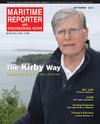
Page 69: of Maritime Reporter Magazine (September 2013)
Workboat Annual
Read this page in Pdf, Flash or Html5 edition of September 2013 Maritime Reporter Magazine
www.marinelink.com 69Assuming that as a young boy growing up in Maine you did not dream of be- come the CEO of a marine transporta-tion company, can you tell us how you came to your career? I grew up in Bremen, Maine, on the coast and a very rural part of Maine. We had a summer home which my grandfather built on an island off the coast. As a child, I would have to go by boat everywhere ? to see my friends, to get a soda ? everything was on the water. Then I went on to Tabor Academy which was in Marion, Mass., and also on the water. After I graduated from North Carolina I joined the Navy and was in for almost eight years. As I transitioned out of the Navy, I was trying to Þ gure out how I could apply the skill sets I had acquired to something where I could make money. Back then (the late 1970s) the marine industry had moved south, principally in the Gulf of Mexico. I had some other peculiar skill sets in that I was a Navy diver, running one of their saturation systems. I came to places like Houston and New Orleans and met with many companies, one of which was Kirby, which back then was an oil & gas exploration company with a small marine subsidiary called Dixie Carriers, then a $30-40m business. I joined Dixie Carriers in February of 1978, which was a wholly owned subsidiary of Kirby. Did you start at the top? No. I had a variety of roles at Dixie Carriers, starting out as a project engineer, then moved to human resourc-es, then to safety and operations, and I was named president in 1984. At this time the company was about $35m in revenue, 150 employees and maybe 18-20 boats and 40-50 barges. How would you describe the business during this period? This was in the middle of a very difÞ cult time in the business, as they (like many others) had overbuilt. But you could see that this is a great busi-ness, a business that is fundamentally important to the U.S. economy. It is the best and the safest way to move bulk products throughout this country. The inland waterway system is a magniÞ cent transportation system, perfectly located through the center of the country which really connects the heartland to the world. We were principally a liquid car- rier back then, and the liquid business, particularly the chemical business lends itself to water transportation. Given that this was a fundamentally important busi-ness, one that wasn?t going to go away. It was apparent to me that if you had the vi-sion and the means, you could grow that business into a super franchise.So it was smooth sailing from there? Not exactly. The parent com- pany (not the barge line) had some Þ nan-cial trouble back then, because simply they weren?t really successful in Þ nd-ing oil and gas. In 1987 the board made the decision to get out of the oil and gas business and focus on the transportation business. That?s when we began to grow. After 50 acquisitions and a lot of hard work from a group of great people, we?re where we are today: about 350 inland towboats and tugboats and 950 offshore tank barges, and we employ about 4,600, which in-cludes about 2,600 seamen and staff in our diesel engine business.People are often touted as a company?s most valuable assets. Your thoughts? The heart of the company are the employees. They see the customers more, they spend the money, they?re the ones that deliver the service. A lot of our success is recognizing that we are not just a marine transportation company. We are a service company that uses ma- rine assets to do what our customers pay us to do: move their product safely and reliably. (Photo: Greg Trauthwein) Pyne pictured with his beloved Maine coast as a backdrop. MR #9 (66-73).indd 69MR #9 (66-73).indd 698/30/2013 10:19:14 AM8/30/2013 10:19:14 AM

 68
68

 70
70
